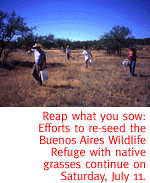
Volunteers Are Taking Small Steps Toward Big Change At The Buenos Aires Wildlife Refuge.
By Kevin Franklin
A DOZEN PEOPLE march through the field, reaching into buckets
and tossing grains into the air like some lost wedding recessional
in search of a bride and groom.
We're tossing native grass seeds to the wind in an effort to
kick-start some natural growth out here on the Buenos Aires Wildlife
Refuge southwest of Tucson. In a co-effort with the U.S. Fish
and Wildlife Service, the Arizona League of Conservation Voters
Habitat Fund is scattering truckloads of seeds over a 120-acre
part of the refuge. Hopefully monsoon rains will inspire these
seeds to grow into towering native bunch grasses. It's one of
the first steps in restoring the refuge to its former glory before
100 years of heavy cattle grazing turned it into a haven for tumbleweeds
and stumpy mesquite trees.
 "At one time, there were 300 species of grasses out here,"
AZLCV Director Bob Beatson says. "It must have been an unbelievable
site after the monsoons. Because the native grasses grow in clumps
and tracts, it must have been a patchwork of color. That is, until
the coming of the bovine range maggots (cows)."
"At one time, there were 300 species of grasses out here,"
AZLCV Director Bob Beatson says. "It must have been an unbelievable
site after the monsoons. Because the native grasses grow in clumps
and tracts, it must have been a patchwork of color. That is, until
the coming of the bovine range maggots (cows)."
With help from volunteers from Tucson, Beatson is hoping to continue
the effort this weekend by planting a five-acre patch currently
devoid of plant life.
"When we planted grass before it was restoration, but this
is a rebuild," Beatson says of the moonscape terrain.
As it stands now, the ground in question has no hope for supporting
any native species. By planting a hardy pioneer species like needle
grama, they hope to begin the process of healing the landscape.
AZLCV volunteer coordinator Jenny Neeley hopes to get a good crowd
out this Saturday in order to get the seeds planted.
"We want to establish a ground cover on this barren patch,"
Neeley says. "That will set the stage for some other kinds
of grasses to grow."
"Needle grama," says Beatson "is the nasty shit
that sticks in your socks, but it's a native. If we had planted
it before this recent monsoon rain, that field would be green
now. If you don't take a shower for a few days and then put one
of these in your ear it will start to grow," he jokes.
With tactical strikes like this, everyone involved with the project
hopes to give native grasses a leg-up on the non-natives currently
dominating the refuge.
"The fact that this area is not grazed will help it recover,"
Beatson says. "The problem is we're talking about 200 square
miles, and so far we've only seeded 120 acres. Without the budget
of the Army Corps of Engineers there's only so much we can do.
Native grasses grow in clumps, so we're making a clump here and
a clump there."
Even with the limited resources at hand, the refuge has already
begun to show signs of healing after removing the cows when the
FWS bought the land in 1985.
 "Compared to grazed land it's no contest, both in biomass
and number of species," Beatson says. "Some of the local
ranchers, even though they're not real keen on the refuge, are
being shamed into changing some of their management practices.
They didn't like the (creation of the) refuge and felt they could
do just as well of a job healing the land. Well, now they have
to prove it. If you have eyes you can see the difference between
here and grazed land."
"Compared to grazed land it's no contest, both in biomass
and number of species," Beatson says. "Some of the local
ranchers, even though they're not real keen on the refuge, are
being shamed into changing some of their management practices.
They didn't like the (creation of the) refuge and felt they could
do just as well of a job healing the land. Well, now they have
to prove it. If you have eyes you can see the difference between
here and grazed land."
The biggest challenge facing those who want to restore the land
to its natural state is the resilience of exotic grasses introduced
to feed cows.
"The exotics are our toughest challenge. A lot of natives
were overgrazed. Lehmann's lovegrass was introduced, but the cows
preferred the native grasses so they preferentially ate all the
natives. A lot of things don't eat (Lehmann's love grass). It's
one of the most drought-resistant grasses around, so it's out-competing
all the natives. The only grass that's more drought-resistant
is the grass that ate the West--buffel grass (another troublesome
exotic)."
The problem with exotic grasses it that they don't provide the
food and cover native mammals, birds, reptiles and insects require.
When the native grasses go, so do the animals that depend on them.
"At the rate the non-profits (like the Arizona League of
Conservation Voters Habitat Fund) can do things," Beatson
says, "you'll see small changes in certain areas--which is
all we're trying to do. Hopefully over time, it'll start to change
on a larger scale."
But that will have to start with
small-scale help from volunteers this Saturday.
Getting There
To help bring back a native grassland, call the Arizona League
of Conservation Voters at (520) 622-2819, or show up
before 8 a.m. on Saturday, July 11, at milepost 27 on Highway
286. Take Highway 86 west out of Tucson, towards Three Points.
When you see the gas station, turn left onto Highway 286 and head
south.

|





